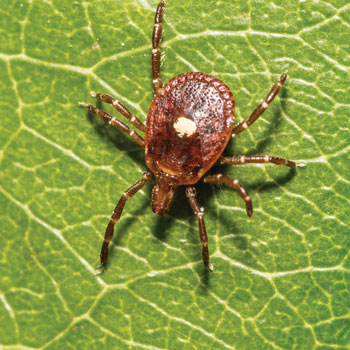What to know about alpha-gal syndrome
Awareness about alpha-gal syndrome remains low, but the number of suspected cases of people bitten by ticks who develop this allergic reaction has risen sharply since 2010.
Ticks can pose a variety of health risks, including Lyme disease and ehrlichiosis. But a recent pair of studies in Morbidity and Mortality Weekly Report (MMWR) highlighted a less well-known condition associated with tick bites: alpha-gal syndrome, or the red meat allergy.
Alpha-gal syndrome causes hypersensitivity to a sugar that can be found in pork, beef, rabbit, venison, and dairy products, as well as some pharmaceutical products derived from mammals, according to the CDC. Patients develop the allergy after being bitten by a tick that has the sugar in their saliva and weeks to months later will exhibit allergic symptoms after consuming red meat or other products with alpha-gal. These include nausea or vomiting, diarrhea, drops in blood pressure, and hives or anaphylaxis.

Awareness about alpha-gal syndrome remains low, but while only a portion of people bitten by ticks will go on to develop this allergic reaction, the number of suspected cases has risen sharply since 2010, especially in states home to lone star ticks. To learn more about the syndrome and its prevalence, I.M. Matters spoke with Ann Carpenter, DVM, MPH, an epidemic intelligence service officer with the Rickettsial Zoonoses Branch at the CDC's Division of Vector-Borne Diseases.
Q: What's the CDC's latest research on alpha-gal syndrome?
A: We have two recent reports out in MMWR. The first report is a survey among 1,500 health care providers across the U.S. We wanted to understand health care provider knowledge and practices related to alpha-gal syndrome and understand knowledge gaps. We know from the literature that there's a delay in diagnosis of patients with alpha-gal syndrome. We found that almost half, or 42%, of those health care providers who we surveyed had never heard of alpha-gal syndrome, and about one-third had little confidence in their ability to diagnose their patients with alpha-gal syndrome.
We also conducted a second study evaluating results from serum tested for alpha-gal specific IgE antibodies, which is the primary tool used to diagnose people with alpha-gal syndrome. We gathered test results from 2017 to 2022 from the primary commercial lab that was diagnosing people in the United States, and we found an increase in the number of people that were considered suspected cases of alpha-gal syndrome. So, combined with the prior study that CDC performed, from 2010 to 2022, just about 110,000 people tested positive, with an annual increase in those testing positive. We want to raise awareness about this tick bite-associated allergy or allergic condition to improve patient care and to improve our understanding of alpha-gal syndrome.
Q: Is the only way to get the syndrome from a tick bite?
A: This allergy develops after a tick bite. There's a sugar in tick saliva that people are sensitized to after they're bitten by ticks. Maybe weeks or months later, if they are exposed to this sugar in meat, say they eat a hamburger for dinner, then they will develop an allergic reaction. Just to make sure I'm clear on this, eating red meat does not cause alpha-gal syndrome.
Q: What are some challenges physicians face when it comes to diagnosing the condition?
A: Alpha-gal syndrome can be challenging to diagnose. The symptoms can be consistently inconsistent, meaning that some patients can present with only a rash, some with only [gastrointestinal] symptoms, or some with anaphylaxis. Within the same patient, that reaction can be different every time.
A key component of alpha-gal syndrome is that the allergic reaction is delayed. Following exposure, patients typically don't develop an allergic reaction for at least two hours. So, it can be challenging to identify the association between consuming a mammalian product or a medical product that has mammalian products in it and then this delayed allergic reaction a couple hours later.
Q: What additional factors contribute to low testing rates?
A: When we evaluated health care provider knowledge of alpha-gal syndrome, we found that less than a third of providers knew the correct diagnostic tests to order to confirm alpha-gal syndrome. It's diagnosed by a combination of clinical history, physical exam, and then serum IgE to alpha-gal. So, if less than a third of those health care providers we surveyed knew how to diagnose it, we suspect that 110,000 cases is an underestimate of the true number of cases of alpha-gal syndrome in the U.S.
We do know that there is typically a prolonged time from onset of symptoms to diagnosis. Previous research suggests that only 21% of patients are diagnosed in their first year of illness and those remaining 79% may take years to be diagnosed. We also know that access to care can be particularly challenging, because diagnosis typically requires repeated visits to health care providers. It may require visits to specialists like allergists. People with alpha-gal syndrome may not have access to that health care, so there's certainly a health equity aspect of diagnosis that deserves attention.
Q: Is the condition becoming more common?
A: From the second publication in MMWR, we found that the number of tests that were being ordered was increasing each year and the number of people with positive tests was increasing each year. It is difficult to determine if the increase in cases is due to an emergency of this condition or increases in awareness and testing or possibly a combination. Until 2022 there was one primary commercial lab that was doing most of the testing for alpha-gal syndrome in the U.S., although some academic or university labs were offering testing during this time as well. But today, there are more commercial labs that are offering testing, which we hope will increase the number of people being tested. Alpha-gal syndrome is not a nationally notifiable condition, so states are not required to report their cases of alpha-gal syndrome to the CDC, so our national awareness of case counts is limited to examining lab testing data.
Q: Do you expect incidence to increase due to climate change as tick season extends?
A: That is a tricky question. We know that, right now, the distribution of positive test results mimics the distribution of lone star ticks. We know that tick distribution and abundance are affected by a number of factors: distribution of wooded areas where tick hosts live, such as deer and small mammals, the nature of the contact between ticks and people, how many people are outside in those areas and at risk of experiencing a tick bite. When we think about what is affecting tick populations, we need to look closely at where the hosts that those ticks are feeding on live and are distributed, and the nature of contact between ticks and humans, which all may be impacted by changes in land use and climate.
Q: What more would you like to see done to increase education among clinicians?
A: We did develop a Medscape CME training for health care providers to help increase knowledge around alpha-gal syndrome. We found that about two-thirds of health care providers noted that guidance on the diagnosis and management of alpha-gal syndrome would be helpful resources. We are working to help increase health care provider knowledge and public knowledge to prevent delays in diagnosis and improve patient care.
Q: Because the condition varies by geography, would you like to see more region-specific interventions to raise awareness?
A: I absolutely think that it's important for physicians to consider diseases and conditions that are perhaps more prevalent in their areas and recognize that the distribution of the majority of alpha-gal syndrome cases follows the range of the lone star tick, as well as ehrlichiosis.
We see more of these positive test results in the Southeast and in the mid-Atlantic, as well as in the South and the Midwest. I think understanding where these ticks are, where people are at risk, is important, but also recognizing that there's the potential for exposure through travel. If someone is going on vacation in an area where these ticks are located and then goes home, that doesn't mean that they're not at risk of developing alpha-gal syndrome following a tick bite. That can certainly make diagnosis difficult too, and people may not be aware of tick bites. Ticks can be very small, especially in the larval and nymphal stages, and [patients] may not ever recall a tick bite, so understanding that lack of memory of a tick bite should not be an exclusion criterion for a diagnosis of alpha-gal syndrome [is important].
Q: Is there anything else you want physicians to be aware of?
A: A key component of preventing alpha-gal syndrome is preventing tick bites, so taking those same actions that we know can prevent Lyme disease, ehrlichiosis, other tick-borne diseases—wearing an EPA-approved tick repellent, showering, and checking for ticks when you return inside—are really critical. We know that there is no treatment for alpha-gal syndrome and so prevention is especially important.




